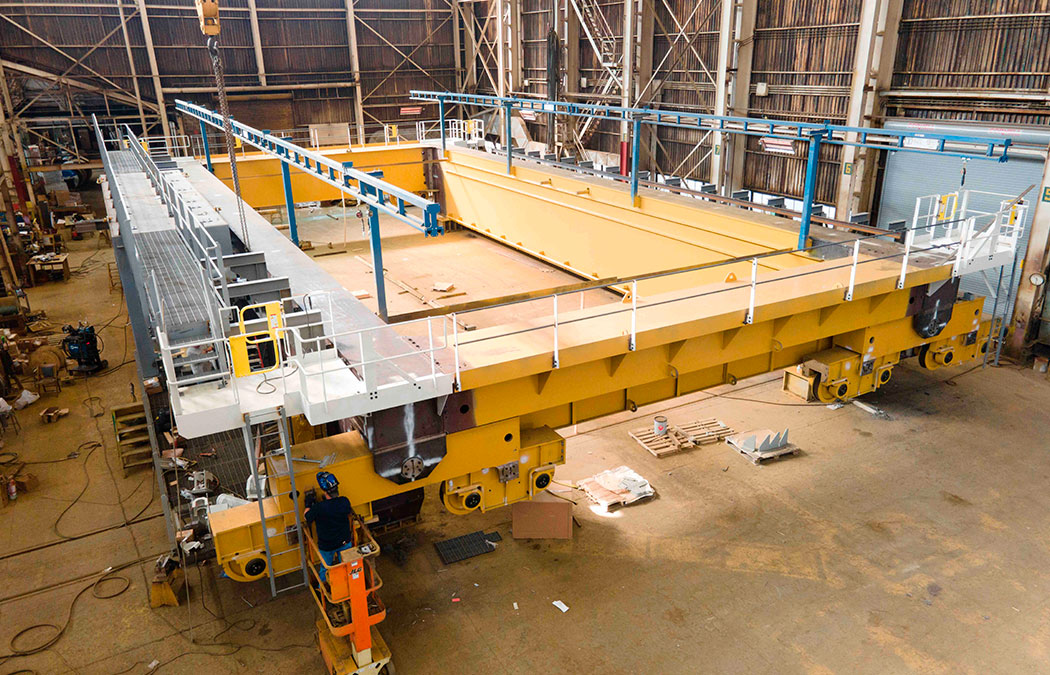Bridge cranes, often known as overhead cranes, are an essential piece of machinery in industries that require efficient heavy lifting and material handling. These cranes are widely used in environments such as manufacturing plants, warehouses, construction sites, and steel mills. Their ability to lift and move heavy loads with precision across a wide area makes them invaluable tools for improving productivity, reducing labor costs, and ensuring the safety of workers.
In this article, we will delve into the benefits, key features, and common applications of bridge crane, highlighting how they are revolutionizing heavy lifting in industrial operations.
1. What is a Bridge Crane?
A bridge crane is a type of overhead crane designed to move heavy loads across a large workspace. It consists of a horizontal bridge, typically mounted on two parallel runways. The crane’s hoist or trolley runs along the bridge, lifting and transporting materials vertically and horizontally. Depending on the configuration, bridge cranes can be used for both light-duty and heavy-duty lifting applications.
Bridge cranes come in two main configurations:
-
Single-Girder Bridge Cranes: These cranes have one horizontal beam, or girder, that supports the hoist and trolley. They are suitable for lifting lighter loads and are more economical for less demanding tasks.
-
Double-Girder Bridge Cranes: These cranes feature two horizontal beams for enhanced strength and stability, allowing them to handle heavier loads. They are commonly used in heavy-duty industrial applications that require higher lifting capacities.
2. Key Features of Bridge Cranes
bridge crane come with several features that make them effective tools for material handling in industrial environments. Below are some of the key features:
a. High Lifting Capacities
Bridge cranes, particularly double-girder models, are capable of lifting heavy loads ranging from a few tons to several hundred tons. This makes them ideal for industries that handle large and cumbersome materials, such as steel, construction materials, or heavy machinery.
b. Precise Load Control
Modern bridge cranes are equipped with advanced control systems that allow operators to control the movement of the hoist both vertically and horizontally. This precision ensures that materials are moved to their exact destination with minimal risk of damage.
c. Overhead Design
The overhead design of bridge cranes allows them to operate without taking up valuable floor space. This feature is especially beneficial in areas where floor space is limited and maximizing space utilization is crucial.
d. Safety Features
Bridge cranes are designed with various safety mechanisms to protect both operators and the equipment. These include overload protection, emergency stop functions, anti-collision systems, and automatic shutdown in case of a malfunction. Safety is a top priority in environments where heavy lifting and precise control are necessary.
e. Customizable Configurations
Bridge cranes can be customized to meet the specific needs of different industries. Features such as lifting height, span length, lifting capacity, and hoist type can be tailored to suit a variety of applications, ensuring optimal performance.
3. Benefits of Bridge Cranes
The integration of bridge cranes into industrial operations offers numerous advantages that can improve efficiency, safety, and profitability. Here are some of the key benefits:
a. Improved Productivity
Bridge cranes can significantly increase productivity by speeding up the movement of materials. By automating the lifting and transportation processes, workers can focus on other tasks, reducing downtime and improving overall operational efficiency. The crane’s ability to move heavy loads quickly also eliminates the need for additional equipment or manual labor, which further enhances productivity.
b. Optimized Space Utilization
Since bridge cranes operate overhead, they don’t require additional space for travel paths like forklifts or other ground-based equipment. This allows for better use of available floor space, which can be utilized for storage, workstations, or additional machinery. In industries like manufacturing and warehousing, this helps maximize operational efficiency.
c. Increased Safety
Manual lifting of heavy materials poses a significant risk to workers. Bridge cranes reduce the need for physical labor by automating material handling, which minimizes the likelihood of workplace injuries such as strains, sprains, and musculoskeletal disorders. The crane’s control systems are designed to operate with safety in mind, incorporating features like load limiters and emergency stops to protect workers and equipment.
d. Cost-Effective Solution
Although the initial investment in a bridge crane may be significant, the long-term benefits often outweigh the costs. By increasing productivity, reducing labor costs, and minimizing the risk of damage to materials or equipment, bridge cranes offer a cost-effective solution for industries that require heavy lifting. Furthermore, their durability ensures that they provide a long service life with minimal maintenance.
e. Precision and Accuracy
Bridge cranes offer exceptional precision when lifting and moving materials. Operators can control the crane’s movements with great accuracy, ensuring that heavy items are lifted and placed exactly where needed. This level of control is particularly beneficial when working with fragile or high-value materials that require careful handling.
4. Applications of Bridge Cranes
Bridge cranes are widely used across various industries for heavy lifting and material handling. Some of the most common applications include:
a. Manufacturing
In manufacturing environments, bridge cranes are often used to move raw materials to production lines, transfer parts between workstations, and transport finished products to storage or shipping areas. Their ability to lift and move large items quickly and efficiently makes them an essential part of the production process. In industries such as automotive, aerospace, and electronics, bridge cranes are used to handle everything from components to finished assemblies.
b. Construction
Construction sites require heavy lifting equipment to move large materials such as steel beams, concrete blocks, and heavy machinery. Bridge cranes are used on construction sites to lift and transport these materials efficiently, ensuring that work progresses smoothly. Double-girder bridge cranes are particularly useful for large-scale projects, where significant lifting capacities are needed.
c. Steel Mills and Foundries
Bridge cranes play a crucial role in steel mills and foundries, where they are used to lift heavy steel billets, slabs, and molten metal. These cranes are designed to withstand the extreme conditions of steel production, and they are often equipped with specialized features such as heat-resistant components to handle high temperatures. They are also used to move large molds and other equipment within the facility.
d. Warehouses and Distribution Centers
In warehouses and distribution centers, bridge cranes are used to lift and transport pallets, containers, and other materials across large spaces. By moving items overhead, bridge cranes eliminate the need for forklifts and other ground-based equipment, which can be cumbersome and take up valuable space. This allows warehouses to optimize their layout and increase storage capacity.
e. Ports and Shipping Yards
Bridge cranes, also known as container cranes, are commonly used in ports and shipping yards to load and unload cargo from container ships. These cranes are capable of lifting large shipping containers and moving them onto trucks or storage areas with great speed and precision. Container cranes are essential for keeping shipping operations efficient and ensuring that goods are moved quickly from ships to shore and vice versa.
5. Conclusion
Bridge cranes are vital tools for industries that require the lifting and transportation of heavy materials. With their high lifting capacities, precision control, and safety features, they offer significant advantages in terms of efficiency, productivity, and space utilization. These cranes help reduce labor costs, minimize the risk of injury, and ensure that materials are moved safely and efficiently across large workspaces.
Whether used in manufacturing, construction, steel production, or warehousing, bridge cranes play a pivotal role in optimizing operations and improving overall performance. By investing in a bridge crane, companies can improve their heavy-lifting capabilities and ensure that their operations run smoothly for years to come.




